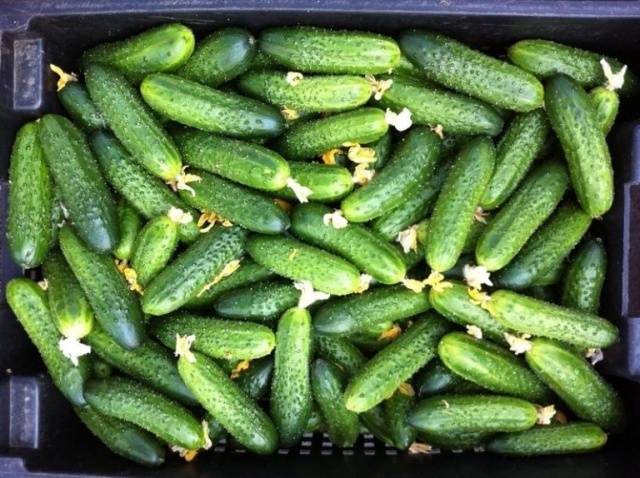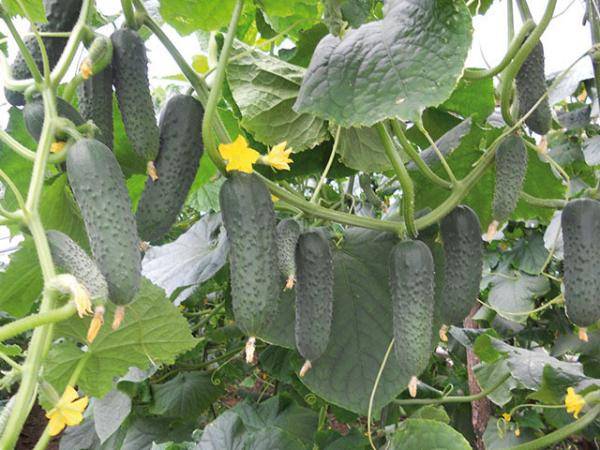Content
Just a few years ago, a magnificent variety of cucumbers, bred by Dutch breeders, appeared and immediately became popular. Numerous positive reviews and descriptions characterize the Gunnar F1 cucumber as an early-ripening variety with excellent taste.
Tall, indeterminate hybrid cucumber bushes with short side shoots are excellent for growing in greenhouses, but they also grow well in outdoor beds.
Characteristics of the variety
Early ripening and high yields make the Gunnar F1 cucumber attractive for industrial plantings. The first harvest of cucumbers can be harvested within 6-7 weeks after emergence. Bushes with large green leaves form from 2 to 4 ovaries in each axil. Cucumbers of the Gunnar F1 variety are characterized by:
- rich green color;
- small in size - the length of the cucumber is no more than 12-15 cm;
- cylindrical, rounded at the ends, shape;
- lumpy, slightly pubescent skin;
- dense tasty pulp without the slightest bitterness;
- excellent presentation - even overgrown cucumbers of the Gunnar variety do not lose their attractive appearance and taste;
- excellent keeping quality without loss of taste;
- versatility in use;
- excellent transportability;
- the ability to grow cucumbers under film and in open ground;
- high yield when planted in an open area - more than 20 kg per 1 sq. m, and in unheated greenhouses - up to 9 kg per 1 sq. m;
- undemanding to the salt composition of the soil;
- resistance to light frosts;
- resistance to cladosporiosis.
Despite the excellent characteristics of the Gunnar cucumber variety, some of its disadvantages should be noted:
- high cost of seed material;
- insufficient resistance of the Gunnar F1 cucumber to common diseases;
- demanding compliance with agricultural technology.
Sowing seeds
Gunnar cucumbers will produce a decent harvest if you follow the growing rules. Before sowing, it is advisable to soak cucumber seeds in phytosporin; many gardeners advise soaking them in aloe or potassium permanganate juice. Such preventive treatment will provide them with high antibacterial resistance.
Sowing boxes equipped with good drainage should be filled with loose soil. The looseness of the soil mixture will ensure the addition of humus and peat to the garden soil. A small amount of ash would be a good addition. Gunnar cucumber seeds, as reviews advise, are placed evenly over the surface and sprinkled with a layer of soil up to 1.5-2 cm thick. To speed up the germination of cucumber seeds, you need to cover the boxes with transparent film or glass and place them in a room with a temperature of up to 26-27 degrees.
As soon as the Gunnar F1 cucumber shoots hatch, the temperature is reduced to 19-20 degrees. Watering cucumber sprouts is carried out by spraying.The soil should not be allowed to dry out, but it should not remain too wet.
Cucumber growing technology Gunnar recommends transplanting the seedlings to a permanent place after the appearance of 4 true leaves. If Gunnar cucumbers are grown in film greenhouses, transplantation occurs around mid-May. It is not worth keeping cucumber seedlings too long, as their ability to adapt decreases and a large number of sick and weak plants appear, which will affect the harvest.
Many gardeners prefer to sow cucumber seeds in separate containers, which subsequently makes it easier to transplant seedlings into garden beds.
Transplanting seedlings into open ground
Cucumber Gunnar F1 loves open sunny places, protected from the wind. Therefore, the planting site should be selected taking into account these characteristics. The best option would be to create beds with Gunnar cucumbers from north to south.
Cucumber roots need to be provided with good aeration, but it should be noted that the main part of the root system is located horizontally, just a few centimeters from the surface. Therefore, ordinary loosening of cucumber bushes leads to damage to the roots, after which the plants take a long time to recover. Sufficient air access can be ensured by mulching and organic fertilizing, as well as the correct predecessors of Gunnar cucumbers. These include different types of cabbage, peas and other green manure.
Cucumber care
Cucumber shoots form into one stem, and:
- Shoots and ovaries are removed from the first five axils; in cloudy weather, the ovaries are removed in 8 axils;
- from the fifth to the ninth leaf, one fruit is left in the axil;
- in the following axils, all shoots are removed without touching the ovary;
- behind the fifth leaf, a description of the cucumber variety, Gunnar recommends pinching the growing point;
- yellowed lower leaves are systematically removed - the operation should be carried out in the morning or evening;
- at a height of more than 2 m, a horizontal trellis is strengthened, around which the cucumber stem is wrapped;
- during the first two weeks, greens of the Gunnar F1 cucumber variety are harvested without waiting for them to fully ripen;
- in the future, the crop is harvested every other day;
- When fruiting is active, cucumbers of the Gunnar variety are harvested every day.
Organization of watering
The superficial root system of cucumber requires a constant moisture regime. When there is a lack of moisture, plants become stressed and their foliage becomes dark and brittle. Mulching will help retain moisture in the soil. However, excess moisture is also harmful, it leads to:
- to reduce oxygen content in the soil;
- inhibition of the growth of cucumber shoots and fruit formation;
- change in foliage color.
Characteristics of cucumbers Gunnar warns of the appearance of bitterness in cucumbers during sudden changes in humidity and temperature. The best way to water cucumbers is a drip system. If this is not available, you can settle the water in barrels; its temperature when watering cucumbers should not be lower than +18 degrees, and the best humidity indicator is 80%.
Fertilizers for cucumbers
The Gunnar variety is characterized by active fruiting and requires regular feeding:
- for the first time, plants are fed with ammophoska immediately after transplanting into a greenhouse or open beds;
- after rooting in a new place about two weeks later, a complex fertilizer containing all the necessary minerals is applied to the cucumbers;
- after a week you can feed the cucumber bushes of the Gunnar F1 variety with rotted manure;
- before flowering, plants are watered at the root with mineral fertilizer diluted with water;
- after watering, the cucumber beds are sprinkled with ash;
- After fruit set, nitrogen fertilizing is reduced - at this time, cucumbers require potassium and magnesium to ripen and develop taste.
Many summer residents use folk remedies as fertilizers for cucumbers, which become an excellent alternative to mineral supplements - bread yeast, onion peels, stale bread.
Root feeding for Gunnar cucumbers should be applied after watering or rain, preferably in the evening or in cloudy weather. They are more effective in warm seasons. If the summer is cool, it is easier for plants to absorb foliar fertilizers. The procedure for spraying Gunnar cucumbers, as can be seen from the description and photo, is carried out in the evening, the solution is sprayed in small drops and as evenly as possible.
Diseases and pests
If you follow the rules of agricultural technology in greenhouses, cucumbers of the Gunnar variety are not afraid of diseases and pests, but in open ground plants can be damaged by fungal diseases:
- powdery mildew, which can reduce the yield of Gunnar cucumbers by almost half;
- downy mildew, which can practically destroy all plantings.
The best way to combat diseases of cucumbers of the Gunnar F1 variety is to maintain optimal temperature and humidity, as well as preventive treatments with special preparations.
Among the pests, melon aphids or spider mites may appear on cucumber bushes, against which treatments with solutions of tobacco, garlic and other drugs are effective.
Reviews from vegetable growers
The cucumber variety Gunnar F1 is highly valued not only by summer residents, but also by farmers who grow it in greenhouses on an industrial scale.
Conclusion
Cucumber Gunnar F1 has excellent characteristics, which are confirmed by numerous reviews. For many gardeners they have become a real godsend.


















